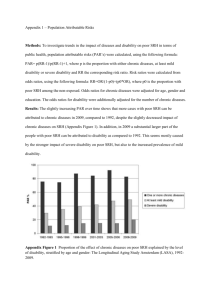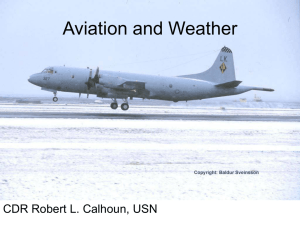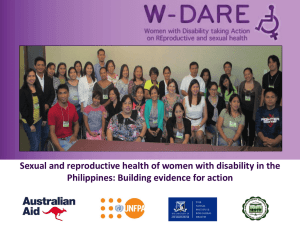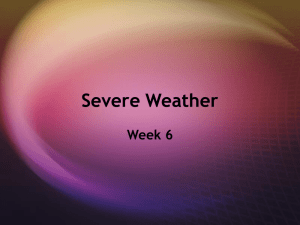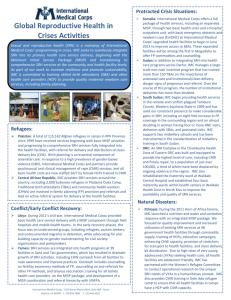NOTES AND CORRESPONDENCE Refined Supercell and Tornado Forecast Parameters 530 E
advertisement
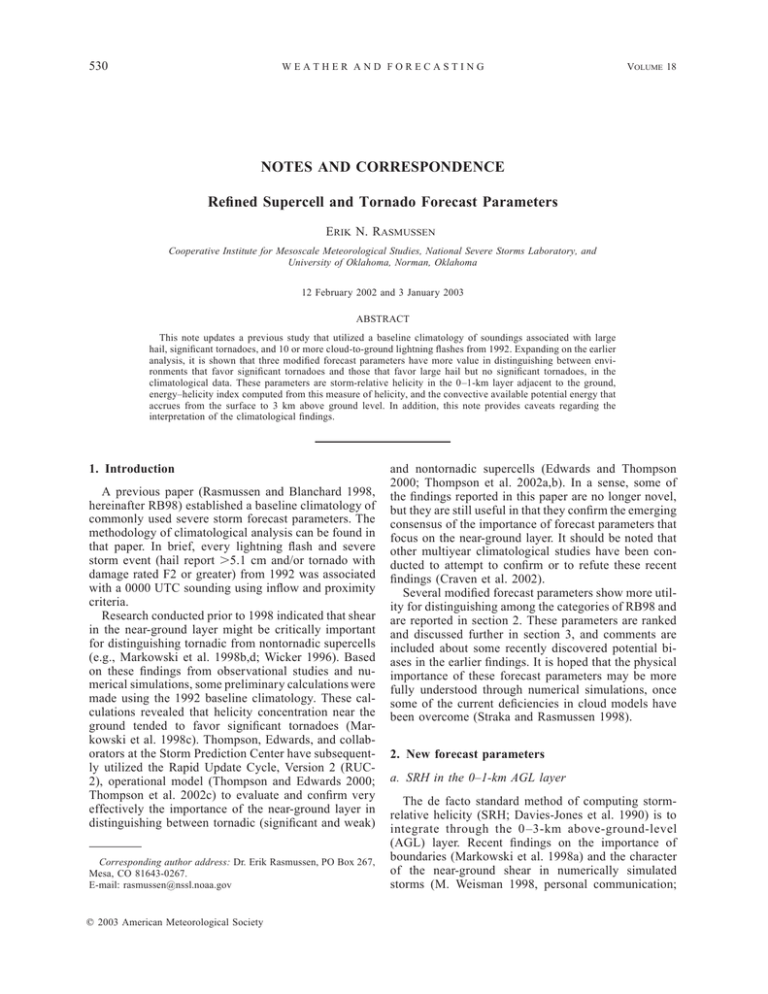
530 WEATHER AND FORECASTING VOLUME 18 NOTES AND CORRESPONDENCE Refined Supercell and Tornado Forecast Parameters ERIK N. RASMUSSEN Cooperative Institute for Mesoscale Meteorological Studies, National Severe Storms Laboratory, and University of Oklahoma, Norman, Oklahoma 12 February 2002 and 3 January 2003 ABSTRACT This note updates a previous study that utilized a baseline climatology of soundings associated with large hail, significant tornadoes, and 10 or more cloud-to-ground lightning flashes from 1992. Expanding on the earlier analysis, it is shown that three modified forecast parameters have more value in distinguishing between environments that favor significant tornadoes and those that favor large hail but no significant tornadoes, in the climatological data. These parameters are storm-relative helicity in the 0–1-km layer adjacent to the ground, energy–helicity index computed from this measure of helicity, and the convective available potential energy that accrues from the surface to 3 km above ground level. In addition, this note provides caveats regarding the interpretation of the climatological findings. 1. Introduction A previous paper (Rasmussen and Blanchard 1998, hereinafter RB98) established a baseline climatology of commonly used severe storm forecast parameters. The methodology of climatological analysis can be found in that paper. In brief, every lightning flash and severe storm event (hail report .5.1 cm and/or tornado with damage rated F2 or greater) from 1992 was associated with a 0000 UTC sounding using inflow and proximity criteria. Research conducted prior to 1998 indicated that shear in the near-ground layer might be critically important for distinguishing tornadic from nontornadic supercells (e.g., Markowski et al. 1998b,d; Wicker 1996). Based on these findings from observational studies and numerical simulations, some preliminary calculations were made using the 1992 baseline climatology. These calculations revealed that helicity concentration near the ground tended to favor significant tornadoes (Markowski et al. 1998c). Thompson, Edwards, and collaborators at the Storm Prediction Center have subsequently utilized the Rapid Update Cycle, Version 2 (RUC2), operational model (Thompson and Edwards 2000; Thompson et al. 2002c) to evaluate and confirm very effectively the importance of the near-ground layer in distinguishing between tornadic (significant and weak) Corresponding author address: Dr. Erik Rasmussen, PO Box 267, Mesa, CO 81643-0267. E-mail: rasmussen@nssl.noaa.gov q 2003 American Meteorological Society and nontornadic supercells (Edwards and Thompson 2000; Thompson et al. 2002a,b). In a sense, some of the findings reported in this paper are no longer novel, but they are still useful in that they confirm the emerging consensus of the importance of forecast parameters that focus on the near-ground layer. It should be noted that other multiyear climatological studies have been conducted to attempt to confirm or to refute these recent findings (Craven et al. 2002). Several modified forecast parameters show more utility for distinguishing among the categories of RB98 and are reported in section 2. These parameters are ranked and discussed further in section 3, and comments are included about some recently discovered potential biases in the earlier findings. It is hoped that the physical importance of these forecast parameters may be more fully understood through numerical simulations, once some of the current deficiencies in cloud models have been overcome (Straka and Rasmussen 1998). 2. New forecast parameters a. SRH in the 0–1-km AGL layer The de facto standard method of computing stormrelative helicity (SRH; Davies-Jones et al. 1990) is to integrate through the 0 –3-km above-ground-level (AGL) layer. Recent findings on the importance of boundaries (Markowski et al. 1998a) and the character of the near-ground shear in numerically simulated storms (M. Weisman 1998, personal communication; JUNE 2003 NOTES AND CORRESPONDENCE 531 FIG. 2. Scatter diagram of SRH 0–1 vs SRH 2–3 for soundings representing the three classes described for Fig. 1. Labeled lines have constant ratio of SRH 0–1 to SRH 2–3 . FIG. 1. Box-and-whiskers graph of 0–1-km AGL SRH for soundings associated with significant tornadoes (TOR; on right), soundings with hail .5.1 cm in diameter but without significant tornadoes (SUP; in middle), and nonsevere thunderstorms (ORD; on left). Gray boxes denote 25th–75th percentiles, with heavy horizontal bar at the median value. Vertical lines (whiskers) extend to the 10th and 90th percentiles. Wicker 1996) suggest that perhaps the shallower nearground layers are of more importance in affecting the development of supercells and tornadoes (through lowlevel mesocyclone genesis). The data in the 1992 baseline climatology substantiate these findings: they indicate that the 0–1-km AGL SRH (SRH 0–1 ) is a better forecast parameter for distinguishing among the TOR and SUP1 classes than the commonly used 0–3-km SRH (SRH 0–3 ), although SRH 0–3 is of more utility in distinguishing between SUP and ORD. The box-and-whiskers diagram for SRH 0–1 is shown in Fig. 1 for direct comparison with Fig. 4 of RB98. Note that Edwards and Thompson (2000) have found a similar signal with RUC-2-derived SRH 0–1 in their analysis of a set of radar-identified supercells. The distributions of SRH 0–3 published in RB98 are similar in appearance to those shown in Fig. 1. Thus, it is legitimate to ask whether there is any additional information in SRH 0–1 or whether large SRH 0–1 is simply a contribution to large SRH through the deeper layer. In examining the vertical distribution of SRH it is found that it varies among the categories and that SRH 0–1 is 1 RB98 defined the categories as follows: TOR were soundings associated with at least one tornado of F2 or greater damage intensity, SUP were soundings associated with at least one report of hail .5.1 cm in diameter but no tornadoes of F2 or greater damage intensity, and ORD soundings were associated with at least 10 cloud-to-ground lightning flashes but no severe weather reports of any type. not simply related to the deeper layer measure. One aspect of this variation is illustrated by Fig. 2, which is a scatter diagram of SRH 0–1 against that in the 2–3-km AGL layer (SRH 2–3 ). Category TOR soundings in which the SRH 2–3 is larger than SRH 0–1 (SRH 0–1 /SRH 2–3 , 1.0) are seldom found. TOR soundings preferentially have SRH 0–1 that is much larger than SRH 2–3 . The current investigation makes it clear that SRH 0–1 is of more value in distinguishing between TOR and SUP than is the quantity customarily computed. The vertical distribution of SRH also has been examined by Edwards and Thompson (2000), who report a similar finding. b. Modified EHI In RB98, it was verified that combinations of convective available potential energy (CAPE; here computed as in RB98) and low-level shear were generally better forecast parameters than measures of shear or CAPE alone. Herein, CAPE is combined with SRH 0–1 in a modified version of the energy–helicity index (EHI; Hart and Korotky 1991). This modified version (EHI 0–1 ) is identical to the traditional form except for the substitution of the SRH 0–1 . The scatter diagram of this parameter space is given in Fig. 3 (for direct comparison with Fig. 11 of RB98), and the box-and-whiskers diagram is shown in Fig. 4 (for direct comparison with Fig. 12 of RB98). This formulation of EHI is substantially better at distinguishing between the TOR and SUP classes than is any parameter in RB98 (refer to Table 1). Only 25% of the SUP soundings had EHI 0–1 . 0.5, whereas nearly 2/3 of the TOR soundings had values this large. The improvement of EHI 0–1 over the conventional EHI can only be due to the improvement of the SRH 0–1 over its 0–3-km counterpart. As shown in Table 1, this version of the EHI is somewhat poorer in the SUP/ORD forecast discrimination than is the traditional EHI. This finding is similar to that reported by Markowski et al. (1998d) and Edwards and Thompson (2000). 532 WEATHER AND FORECASTING VOLUME 18 FIG. 3. As in Fig. 2, but for the CAPE vs SRH parameter space of EHI 0–1 . Labeled curves are lines of constant EHI. c. CAPE below 3 km AGL RB98 established that lifting-condensation-level (LCL) height was one of the most important parameters distinguishing between the TOR and SUP categories (see their Table 3). There are various possible explanations, including the fact that low LCLs are associated with humid near-ground air (ergo reduced low-level evaporative cooling and downdraft production) as well as the possibility of relatively larger CAPE (and thus perhaps vertical stretching) occurring closer to the surface. The latter explanation is investigated further after being first explored by McCaul (1991) and McCaul and Weisman (1996). Using the baseline climatology, the 0– 3-km AGL CAPE (CAPE 0–3 ) was investigated and was found to have a relatively strong ability to discriminate between the TOR and SUP classes while having very little value in the SUP/ORD forecast (Fig. 5 and Tables 1 and 2). This finding, although requiring further investigation, strongly suggests that the development of tornadoes does require some near-ground CAPE, whereas this is not so important for storms that produce large hail but not significant tornadoes. This may be because near-ground CAPE is associated with more effective interaction between low-level shear and low-level updraft, thereby augmenting ascent and stretching through the nonhydrostatic pressure field (Rotunno and Klemp 1982). In RB98, the CAPE in the lowest 3 km above the level of free convection was considered but found to be of little forecast utility. TABLE 1. Parameters ranked according to Heidke’s skill score in the TOR vs SUP forecast when HSS . 0.29. VGP is the vorticity generation parameter (RB98); CIN is convective inhibition. FIG. 4. As in Fig. 1, but for EHI 0–1 . Parameter Optimal HSS Optimal value EHI 0–1 SRH 0–1 LCL CAPE 0–3 CIN VGP 0.355 0.349 0.348 0.336 0.297 0.295 0.725 120 m 2 s22 800 m 69 J kg21 16 J kg21 0.31 JUNE 2003 533 NOTES AND CORRESPONDENCE TABLE 2. Parameters ranked according to Heidke’s skill score in the (SUP 1 TOR) vs ORD forecast when HSS . 0.15. BL–6 km shear is the magnitude of the shear vector between the boundary layer and 6 km AGL. FIG. 5. As in Fig. 1, but for CAPE 0–3 . 3. Discussion and conclusions In RB98, forecast parameters were ranked according to Heidke’s skill score (HSS; Doswell et al. 1990). Herein, the parameters (RB98 and the modified parameters) are reranked and presented in Tables 1 and 2. From Table 1 it can be seen that EHI 0–1 has assumed the first position and that SRH 0–1 has assumed the second position in the TOR/SUP forecast utility rank. The optimal parameter value is found by seeking the value producing the largest HSS. The relatively large HSS for CAPE 0–3 may be one indication that low-level stretching is important in the TOR/SUP discrimination. The general purpose of this note was to update RB98, and attention is now focused on the findings concerning the LCL that were reported therein. In conversations concerning the importance of the LCL in forecasting significant tornadoes, some interesting questions have been posed that motivated an examination of the geographical distributions of SUP and TOR events as well as LCL heights. Assume that the RB98 interpretation of the importance of LCL height is correct. That is, low LCLs favor formation of significant tornadoes because they somehow alter the rear-flank downdraft and outflow character of supercells. If this hypothesis is correct, it should apply regardless of geographical location. It was Parameter Optimal HSS Optimal value EHI SRH 0–1 EHI 0–1 VGP SRH Mean shear BL–6 km shear CAPE 0.386 0.356 0.355 0.315 0.268 0.227 0.189 0.179 1.40 180 0.72 0.280 230 m 2 s22 0.009 63 s21 20.5 m s21 2100 J kg21 found that, in the 1992 dataset, SUP events rarely occurred east of the Mississippi River (Fig. 6) but are relatively much more common in the High Plains. Thus, it is impossible to test the hypothesis in the eastern United States, and the null hypothesis (LCL does not have value at predicting SUP vs TOR) is permitted in that region. Further, when the LCL heights associated with all SUP and TOR soundings combined are examined geographically (Fig. 7), it can be seen that, when severe storms occur, the LCL is climatologically large in the High Plains owing to the typically drier boundary layer. It could be argued that the RB98 result simply showed that large LCL heights and storms with large hail occur together in the High Plains, but the reasons have little to do with the occurrence or nonoccurrence of significant tornadoes. In fact, recent work by Thompson et al. (2002c) has demonstrated that about 90% of the storms that produce large hail (RB98 2-in. criterion) are supercells, but nearly 2/3 of radar-identified supercells do not produce hail this large. This, too, argues that it is possible that the RB98 finding regarding low LCL height had more to do with environments that support large hail occurrence at the ground than promoting the occurrence of significant tornadoes. This geographical analysis points the way to some FIG. 6. Geographical distribution of TOR (squares) and SUP (diamonds) soundings. Symbol size varies linearly with number of soundings, with the largest symbol on the graph representing 12 soundings. 534 WEATHER AND FORECASTING VOLUME 18 utility. Among these is a modified measure of SRH from the 0–1-km layer, and the associated EHI based on this same layer. Further, it was shown that CAPE that accrues below 3 km AGL might be important in discriminating between environments supportive of significant tornadoes and those that are not. Information was also presented that points toward the need for further research into the possible bias in the significant tornado climatology that might be present because tornadoes from high-based storms appear weaker and occur in geographical regions in which damage is much less likely to occur. FIG. 7. Distribution of average LCL height for all SUP and TOR soundings at each sounding site. The symbol sizes vary linearly from zero to the maximum average LCL height observed (3477 m). Gray symbols represent sites with #median number of soundings (three). badly needed additional research to add more knowledge regarding the use of the LCL as a tornado forecast parameter. In particular, a large climatological dataset of identified supercells, their tornadic character, and low-level humidity must be assembled to further test low-level humidity as a forecast tool. The work of Thompson et al. (2002b) makes much progress in this direction, because it uses radar supercell identification instead of the RB98 large-hail proxy. Their work supports the finding that low LCL height favors significant tornadoes. However, the problem of tornado intensity assessment in the high-LCL environment remains unsolved. When assessing tornado character, it will be necessary to devise a means to determine tornado strength rather than relying on the assumption that tornadoes occurring with higher-based storms are small and weak simply because of their less menacing aspect ratios, or because they did not do damage in areas where no structures were present to be damaged. Further research also is required as to what layer is most important in terms of SRH computation for the tornado forecasting problem. The 0–1-km AGL layer was identified herein, but it is possible that a more shallow layer is actually key. However, reported National Weather Service soundings do not have sufficient vertical resolution to quantify near-ground SRH adequately. This note demonstrates that near-ground CAPE is important in distinguishing between soundings associated with significant tornadoes and those associated with large hail but not significant tornadoes. Whether this CAPE is physically important, or is more indirectly related to physically important quantities such as (possibly) low-level humidity, remains to be determined. Further, the optimum near-ground layer for the computation of CAPE has yet to be determined. In summary, this note has demonstrated that certain forecasting parameters can be modified to improve their Acknowledgments. Partial support for this research was provided by the National Science Foundation through Grants ATM-9617318 and ATM-0003869. Additional support was provided by NOAA through a Presidential Early Career Award for Scientists and Engineers. Helpful insights were provided by Drs. Harold Brooks of NSSL, Charles Doswell of CIMMS, Jerry Straka of the University of Oklahoma, and Paul Markowski of The Pennsylvania State University. The examination of the geographical distribution of the TOR and SUP events, as well as LCL heights, was motivated by the interesting research conducted by Mr. Kyle Beatty at the University of Oklahoma. Richard Thompson and Roger Edwards of the NOAA Storm Prediction Center provided much valuable information regarding their recent research using RUC-2 soundings and radar-identified supercells. REFERENCES Craven, J. P., H. E. Brooks, and J. A. Hart, 2002: Baseline climatology of sounding derived parameters associated with deep, moist convection. Preprints, 21st Conf. on Severe Local Storms, San Antonio, TX, Amer. Meteor. Soc., 643–646. Davies-Jones, R. P., D. Burgess, and M. Foster, 1990: Test of helicity as a tornado forecast parameter. Preprints, 16th Conf. on Severe Local Storms, Kananaskis Park, AB, Canada, Amer. Meteor. Soc., 588–592. Doswell, C. A., III, R. Davies-Jones, and D. L. Keller, 1990: On summary measures of skill in rare event forecasting based on contingency tables. Wea. Forecasting, 5, 576–585. Edwards, R., and R. L. Thompson, 2000: RUC-2 supercell proximity soundings, Part II: An independent assessment of supercell forecast parameters. Preprints, 20th Conf. on Severe Local Storms, Orlando, FL, Amer. Meteor. Soc., 435–438. Hart, J. A., and W. Korotky, 1991: The SHARP workstation v1.50 users guide. National Weather Service, NOAA, U.S. Department of Commerce, 30 pp. [Available from NWS Eastern Region Headquarters, 630 Johnson Ave., Bohemia, NY 11716.] Markowski, P. M., E. N. Rasmussen, and J. M. Straka, 1998a: The occurrence of tornadoes in supercells interacting with boundaries during VORTEX-95. Wea. Forecasting, 13, 852–859. ——, ——, ——, and D. C. Dowell, 1998b: Observations of lowlevel baroclinity generated by anvil shadows. Mon. Wea. Rev., 126, 2942–2958. ——, J. M. Straka, and E. N. Rasmussen, 1998c: A preliminary investigation of the importance of helicity ‘location’ in the hodograph. Preprints, 19th Conf. on Severe Local Storms, Minneapolis, MN, Amer. Meteor. Soc., 230–233. ——, ——, ——, and D. O. Blanchard, 1998d: Variability of storm- JUNE 2003 NOTES AND CORRESPONDENCE relative helicity during VORTEX. Mon. Wea. Rev., 126, 2959– 2971. McCaul, E. W., Jr., 1991: Buoyancy and shear characteristics of hurricane–tornado environments. Mon. Wea. Rev., 119, 1954–1978. ——, and M. L. Weisman, 1996: Simulations of shallow supercell storms in landfalling hurricane environments. Mon. Wea. Rev., 124, 408–429. Rasmussen, E. N., and D. O. Blanchard, 1998: A baseline climatology of sounding-derived supercell and tornado forecast parameters. Wea. Forecasting, 13, 1148–1164. Rotunno, R., and J. B. Klemp, 1982: The influence of the shearinduced pressure gradient on thunderstorm motion. Mon. Wea. Rev., 110, 136–151. Straka, J. M., and E. N. Rasmussen, 1998: Thirty years of cloud modeling: Does the emperor wear clothes? Preprints, 19th Conf. on Severe Local Storms, Minneapolis, MN, Amer. Meteor. Soc., 342–347. Thompson, R. L., and R. Edwards, 2000: A comparison of Rapid 535 Update Cycle 2 (RUC-2) model soundings with observed soundings in supercell environments. Preprints, 20th Conf. on Severe Local Storms, Orlando, FL, Amer. Meteor. Soc., 551–554. ——, ——, and J. A. Hart, 2002a: Evaluation and interpretation of the supercell composite and significant tornado parameters at the Storm Prediction Center. Preprints, 21st Conf. on Severe Local Storms, San Antonio, TX, Amer. Meteor. Soc., J11–J14. ——, ——, and ——, 2002b: An assessment of supercell and tornado forecast parameters with RUC-2 model close proximity soundings. Preprints, 21st Conf. on Severe Local Storms, San Antonio, TX, Amer. Meteor. Soc., 595–598. ——, ——, ——, and K. L. Elmore, 2002c: RUC-2 model analysis soundings as a surrogate for observed soundings in supercell environments. Preprints, 21st Conf. on Severe Local Storms, San Antonio, TX, Amer. Meteor. Soc., 591–594. Wicker, L. J., 1996: The role of near surface wind shear on low-level mesocyclone generation and tornadoes. Preprints, 18th Conf. on Severe Local Storms, San Francisco, CA, Amer. Meteor. Soc., 115–119.
